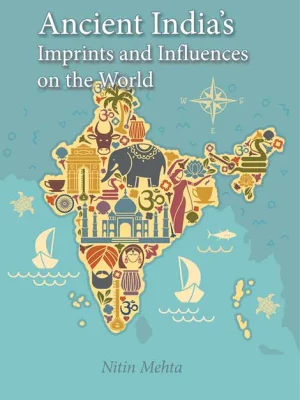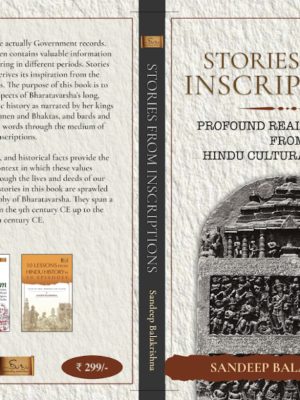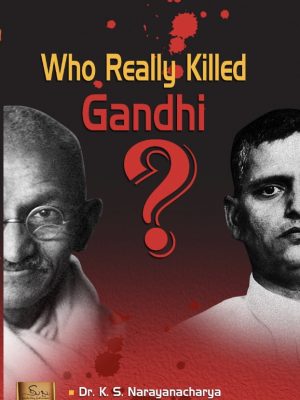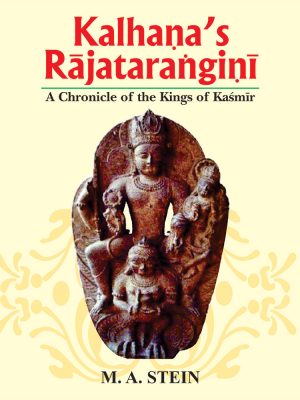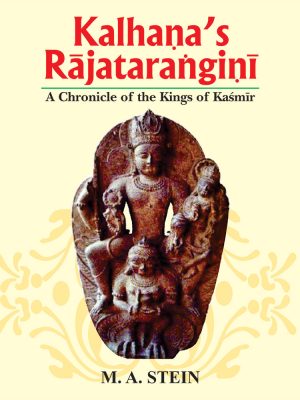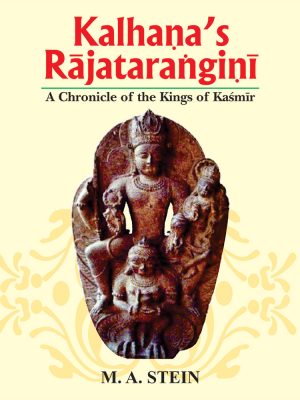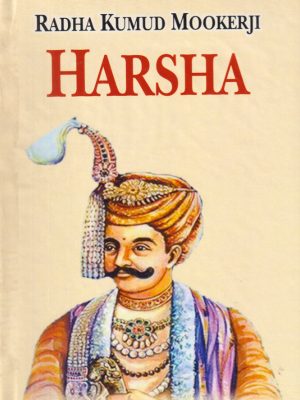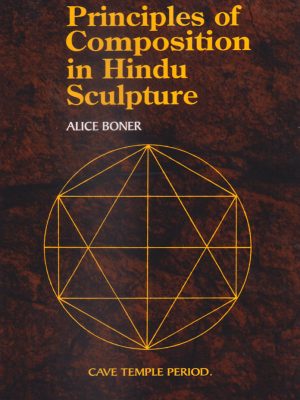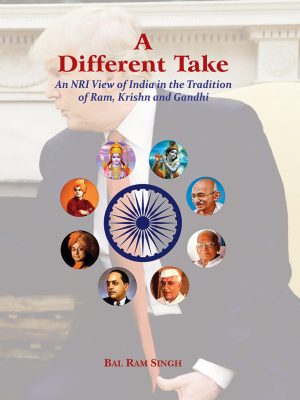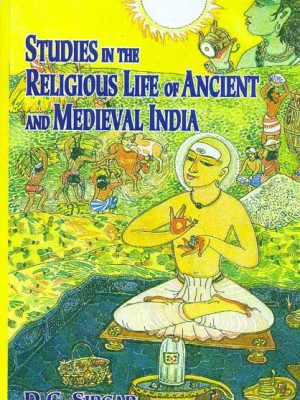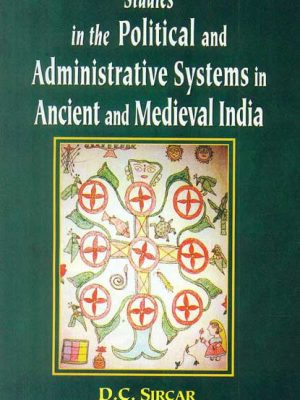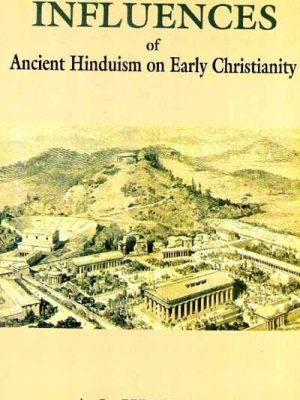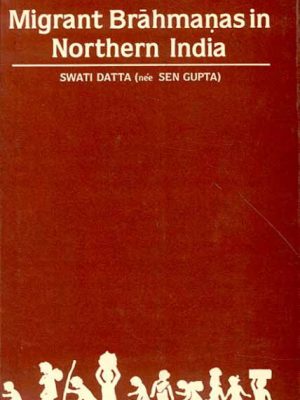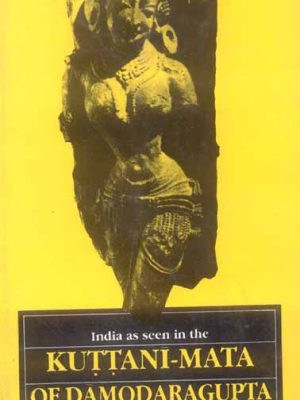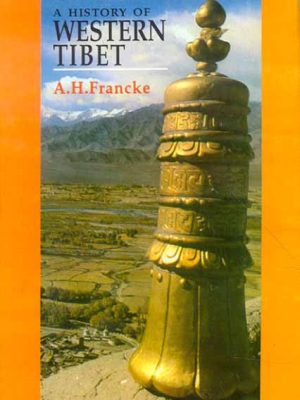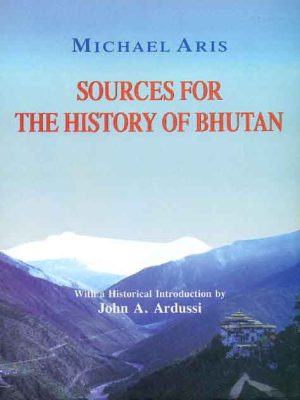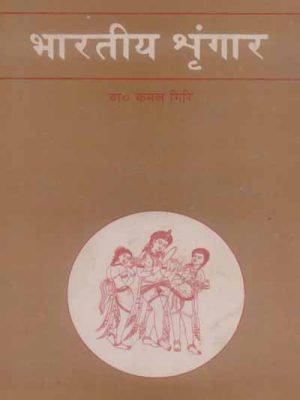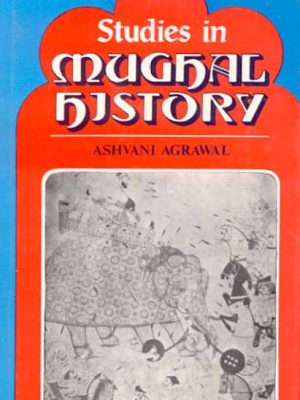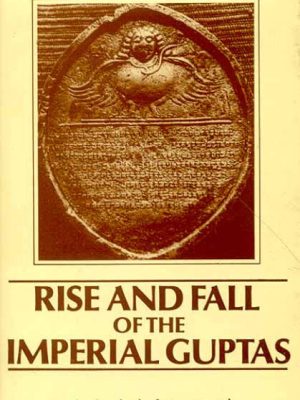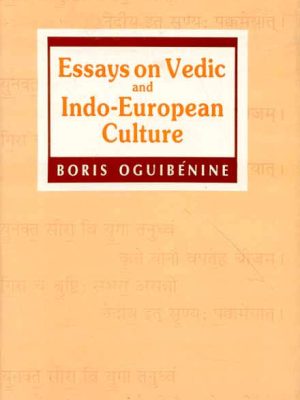History & Culture
Over the centuries there has been a significant fusion of cultures in India. Indian history is a rich mosaic of people and traditions. The political history of this land has been an unending saga of the rise and fall of different empires. The books under this category cast light upon the books to showcase the forgotten culture and history of India. Few books under this category are Education and Social Changes in Bihar, Essays on Vedic and Indo-European Culture, Kingship in Northern India, The Mauryan Polity, and Studies in Mughal History.
-
Ancient India’s Imprints and Influences on the World
- ISBN Hardcover: 9789391024949, 9391024947
- ISBN Paperback: 9789391024475, 9391024475
- Year of Publication: 1994
- Edition: 1st Edition
- No. of Pages: 140
- Language: English
- Publisher: Motilal Banarsidass Publishing House
₹395.00 – ₹695.00Ancient India’s Imprints and Influences on the World
₹395.00 – ₹695.00 -
Stories from Inscriptions : Hindu inscriptions
Hindu inscriptions are actually Government records. Therefore, they provide us authentic and detailed information about historical events and people that they record. A single inscription often contains valuable information related to events occurring in different periods. In fact, some inscriptions are so profound that merit a serious study for its own sake.
Hindu inscriptions also exhibit a powerful element of civilisational and cultural
continuity and reveal the fundamental unity of India cutting across kingdoms and geographies within this sacred land.However, it is astounding to note that till date, there are any number of Indian history scholars who parrot the colonial British falsehood that Hindus have no sense of history. Our inscriptional wealth is perhaps the most glaring proof to the contrary.
₹249.00₹299.00Stories from Inscriptions : Hindu inscriptions
₹249.00₹299.00 -
Who Really Killed Gandhi
Highly intense page by page explosive research on the mystery behind Gandhi’s death. Is now available at just 249/-
₹286.35Who Really Killed Gandhi
₹286.35 -
Kalhana’s Rajatarangini (Vol III): A Chronicle of the Kings of Kashmir
Kalhana’s Rajatarangini is the oldest and fullest record of Kashmir history. Sir Stein, recognising the inestimable value of the only work of its kind, succeeded in publishing the critical edition of the text as early as in 1892 which has been printed here as Vol. III of this three-volume set. Later he followed this illustrious venture by presenting a fully annotated translation of the Chronicle, in two volumes, printed as Vol. I and Vol. II here, the former containing the translation of the first seven tarangas of the original Sanskrit and the latter that of the remaining eighth tarangas.
The translation is preceded by a comprehensive and scholarly Introduction in which Stein has endeavoured to elucidate in the first place the data which can be gathered as regards the person of Kalhana, his family and the milieu in which he lived. In the second chapter (of the Introduction) the author has examined as closely as our available materials would permit, the objects and methods which guided Kalhana in the composition of his work, the sources he used for it, and the form which he gave to his narrative. The condition in which the text of the Chronicle has been handed down to us, and the materials the author has used for its reconstitution, are discussed in the third chapter, while the next chapter contains an exposition of Kalhana’s system of chronolgy. In the concluding and longest chapter of the Introduction it has been the author’s object to present a critical summary of Kalhana’s narrative and of the historical data contained in it. The Chronological and Genealogical Tables attached to the Introduction are intended to present in a condensed form the information furnished by the Rajatarangini regarding the date and descent of successive rulers of Kashmir. The Memoir which follows (Vol. II) the Translation and Notes, presents a connected and detailed account of the ancient geography of Kashmir.
₹695.00 -
Kalhana’s Rajatarangini (Vol II): A Chronicle of the Kings of Kashmir
Kalhana’s Rajatarangini is the oldest and fullest record of Kashmir history. Sir Stein, recognising the inestimable value of the only work of its kind, succeeded in publishing the critical edition of the text as early as in 1892 which has been printed here as Vol. III of this three-volume set. Later he followed this illustrious venture by presenting a fully annotated translation of the Chronicle, in two volumes, printed as Vol. I and Vol. II here, the former containing the translation of the first seven tarangas of the original Sanskrit and the latter that of the remaining eighth tarangas.
The translation is preceded by a comprehensive and scholarly Introduction in which Stein has endeavoured to elucidate in the first place the data which can be gathered as regards the person of Kalhana, his family and the milieu in which he lived. In the second chapter (of the Introduction) the author has examined as closely as our available materials would permit, the objects and methods which guided Kalhana in the composition of his work, the sources he used for it, and the form which he gave to his narrative. The condition in which the text of the Chronicle has been handed down to us, and the materials the author has used for its reconstitution, are discussed in the third chapter, while the next chapter contains an exposition of Kalhana’s system of chronolgy. In the concluding and longest chapter of the Introduction it has been the author’s object to present a critical summary of Kalhana’s narrative and of the historical data contained in it. The Chronological and Genealogical Tables attached to the Introduction are intended to present in a condensed form the information furnished by the Rajatarangini regarding the date and descent of successive rulers of Kashmir. The Memoir which follows (Vol. II) the Translation and Notes, presents a connected and detailed account of the ancient geography of Kashmir.
₹1,300.00 -
Kalhana’s Rajatarangini (Vol I): A Chronicle of the Kings of Kashmir
Kalhana’s Rajatarangini is the oldest and fullest record of Kashmir history. Sir Stein, recognising the inestimable value of the only work of its kind, succeeded in publishing the critical edition of the text as early as in 1892 which has been printed here as Vol. III of this three-volume set. Later he followed this illustrious venture by presenting a fully annotated translation of the Chronicle, in two volumes, printed as Vol. I and Vol. II here, the former containing the translation of the first seven tarangas of the original Sanskrit and the latter that of the remaining eighth tarangas.
The translation is preceded by a comprehensive and scholarly Introduction in which Stein has endeavoured to elucidate in the first place the data which can be gathered as regards the person of Kalhana, his family and the milieu in which he lived. In the second chapter (of the Introduction) the author has examined as closely as our available materials would permit, the objects and methods which guided Kalhana in the composition of his work, the sources he used for it, and the form which he gave to his narrative. The condition in which the text of the Chronicle has been handed down to us, and the materials the author has used for its reconstitution, are discussed in the third chapter, while the next chapter contains an exposition of Kalhana’s system of chronolgy. In the concluding and longest chapter of the Introduction it has been the author’s object to present a critical summary of Kalhana’s narrative and of the historical data contained in it. The Chronological and Genealogical Tables attached to the Introduction are intended to present in a condensed form the information furnished by the Rajatarangini regarding the date and descent of successive rulers of Kashmir. The Memoir which follows (Vol. II) the Translation and Notes, presents a connected and detailed account of the ancient geography of Kashmir.
₹1,200.00 -
Harsha: Calcutta University Readership Lectures 1925
There are very few among the Rulers of India whose history is so rich in both contents and materials as the history of Harsha. His early life and career form the subject-matter of the Harsa-charita of Banabhatta, who wrote on Harsha as his court poet from his personal and intimate knowledge of his life and rule, and has given to Sanskrit literature one of its very few biographical works. The India of Harsha is also described by another eye-witness, the famous Chinese pilgrim, Yuan Chwang, to whose account reads like a Gazetteer in the scope of its inquiry and its wealth of details. To add to these two unique sources, we have several inscriptions of Harsha himself, a few of his great contemporary, Pulakeshin II of the Deccan, and the larger body of inscriptions of the Gupta and later kings of northern India, which together throw considerable light on the history of Harsa, especially on the interesting but imperfectly explored topic of the administrative system developed in that glorious age for the successful governance of extensive empires. The book embodies a course of readership lectures delivered by the late author in Calcutta University.
About the Author(s)
Radha Kumud Mookerji (1884-1964), was an Indian historian and a noted Indian nationalist during the period of British colonial rule. He obtained a doctorate from the University of Calcutta in 1905 and joined the newly established National Council of Education, teaching at the Bengal National College. After 1915, he embarked on a series of tenures at universities in Benares, Mysore, and Lucknow. He was awarded the Padma Bhushan in 1957 for his contribution to Public Affairs. Some of his published books include Indian Shipping: A History of Seaborne Trade and Maritime Activity of the Indians from the Earliest Times (1912), Ancient Indian Education: Brahmanical and Buddhist (1947), reprinted by Motilal Banarsidass (1960), Men and Thought in Ancient India (1912), reprinted by Motilal Banarsidass (1996), The Fundamental Unity of India, A History of India, Chandragupta Maurya and His Times, and Early History of Kausambi.
₹395.00 -
Principles of Composition in Hindu Sculpture: Cave Temple Period
The present study represents an approach to a hitherto unexplored aspect of Hindu sculpture. It deals with premedival sculpture concentrating exclusively on the question of composition have resulted from a careful analysis of the great sculpture of the Rock-Temples at Elura, Badami Mahabalipuram and others of the pre-medival period of the Rastrakuta, Calukya and Pallava Schools.
₹1,495.00 -
A Different Take: An NRI View of India in the Tradition of Ram, Krishn and Gandhi
Bal Ram Singh, PhD, has been a professor since 1990 and Henry Dreyfus Teacher-scholar since 1997 at UMass Dartmouth (until 2014) and at the Institute of Advanced Sciences (INADS), Dartmouth, Massachusetts. He has been visiting professor at Georgetown University, Harvard Medical School, Yang Ming University (Taiwan), and Jawaharlal Nehru University (India). He is currently the President of the Institute of Advanced Sciences and also the founder of Prime Bio Inc., a biotechnology based company.
Dr. Singh is Founding Director of the Botulinum Research Center, established in 2003 and currently located at INADS. He is also the Founding Director of the Center for Indic Studies at the University of Massachusetts Dartmouth.
Dr. Singh is an alumnus of Kamla Nehru Institute Science and Technology of Avadh University, Ayodhya, India, Jawaharlal Nehru University in New Delhi, India and Texes Tech University in Lubbock, TX, USA.
He has been conducting research on botulinum and tetanus neurotoxins, and also on yoga, mind and consciousness. He has published 13 books and over 300 articles, including articles related to India’s philosophy and traditions. He is Editor/Associate Editor of four journals, including Ayurveda Journal of Health and International Journal of Indian Culture and Business Management, Ayurveda – Health Happiness And Harmony Book Series, Motilal Banarsidass.
₹2,600.00 -
Studies in the Religious Life of Ancient and Medieval India
Studies in the Religious Life of Ancient and Medieval India
The topics dealt with are of as varied nature as those in his other Studies. The approach of most writers to the problems relating to Indian religions is based on literary sources; but in respect of the majority of topics discussed in the volume with the exception of the first few chapters, Prof. Sircar depends primarily on inscriptions and supplements epigraphic evidence by the testimony of literary and numismatic records wherever necessary. A few of the studies incorporated in the volume exhibit the author’s search for truth spread over a number of years. Thus his investigation relating to the god Purusottama-Jagannatha of Puri began when he noticed the dominions of Ganga Anangabhima III (1211-39 A.D.) described as ‘Purusottama’s empire’ in an inscription, in 1939. In the course of its progress, he found out, in 1946, how Bhanu II (1305-27 A.D.) is represented in his records as a feudatory of the god Purusottama-Jagannatha and, in 1953, how a literary work speaks of the dedication of the Ganga kingdom to the god by king Anangabhima. Finally in 1963, Prof. Sircar traced in a tenth century epigraph of the Satna District, Madhya Pradesh, how the god of Puri attracted pilgrims from distant regions. The chapter on Purusottama-Jagannatha in the volume is thus the result of a study of about quarter of a century.
₹695.00 -
Studies in the Political and Administrative Systems in Ancient and Medieval India
Studies in the Political and Administrative Systems in Ancient and Medieval India
The earlier chapters of the present volume deal with a large number of topics relating to kingship, landlordism (sometimes mistaken as feudalism), tenancy, royal, charter, Pancayat system etc. Some of the following chapters contain discussions on certain royal officers the functions of some of them or their departments a few aspects of the judicial system some land measures and taxes etc. The third group of topics mostly concerns the interpretation of technical expressions found in epigraphical records.
The last section of the work consists of several appendices which are really some of the author’s recently published studies. Of these, one deals with the democratic traditions of ancient Indian and another with the functioning of the guilds, while a third contains a number of popular conceptions about the duties of Kings. The Subject of the last of the appendices is the traders privileges guaranteed by kings, which has been included here as a topic relating to kingship, though it is equally suitable for a study of economic life.
It will be seen that the book contains the learned author’s views on a great variety of matter respecting the political and administrative systems of ancient and medieval India. The treatment of the majority of topics is primarily based on information gathered from innumerable epigraphic records discovered in various parts of India and is characterised by an unusual mastery of details.
₹695.00 -
Influences of Ancient Hinduism on Early Christianity
Influences of Ancient Hinduism on Early Christianity
This is a work about influences and what “influences” means. Following an analysis of this elusive concept, A. L. Herman presents compelling evidence that the following hypothesis is testable, defendable, and probably true: that the Indus Valley religion with its Savior-God, Siva (2500-1800 B.C.E.), significantly influenced a Greek religion with its Savior-God, Jesus of Nazareth (50-300 C.E.), such that it can be meaningfully claimed that the religion of the Indus Valley civilization probably influenced early Christianity.
₹595.00 -
Migrant Brahmanas in Northern India: Their Settlement and General Impact(C.A.D. 475-1030)
Northern India experienced great crises in the years between C.A. D. 475 and 1030. Many a time this part of the world was the scene of foreign invasions-Empires arose and disintegrated: society and economy changed to a great extent; many Brahman’s of this period migrated.
₹695.00 -
India as Seen in the Kuttanimata of Damodara Gupta
India as Seen in the Kuttanimata of Damodara Gupta
The Kuttani-mata of Damodaragupta is one of the few works in the history of classical Sanskrit literature the time and locale of the composition whereof can be ascertained with a fair degree of certainty. We learn from Kalhana that Damodaragupta occupied a high position under the Karkota-Naga
king Jayapida Vinayaditya who ruled over Kashmir in the closing years of the eighth and early years of the ninth centuries A.D. A critical study of the internal evidence indicates that the work was probably composed a few years after the close of Jayapida’s reign.
As indicated by the title, the text aims at exposing the secrets of the whole craft of prostitution in the form of the advice of an experienced bawd (Kuttani) to a courtesan, and from this point of view it occupies a unique place in the whole range of Sanskrit literature; for the account is
based not only on the standard erotic texts like Vatsyayana’s Kama-sutra but draws copiously upon the poet’s personal observation of the actual state of affairs obtaining in post-Jayapida Kashmir. But the poem has a much wider scope than its professed theme and covers the entire gamut of contemporary life of Kashmir in particular and northern India in general in all its varied aspects and as such forms an important source for the study of contemporary Indian society. The present work attempts a critical evaluation of this evidence in the light of relevant literary and archaeological data. In the process new light is thrown on several important questions.
₹595.00 -
History of Western Tibet: One of the Unknown Empires
History of Western Tibet: One of the Unknown Empires
A History of Western Tibet is based on foreign and western Tibetan sources
of information. The western Tibetan sources of information are records on
stones and on paper. Records on stones cover the period 200 B.C. to 1900
A.D. Records on paper are the chronicles of the Kings of Leh. Though these
are edited ones, much remains to be done.
The readers will find A History of Western Tibet interesting which is the
outcome of scholarly enterprise and research as much as of familiarity with
the country and the people.
The book is profusely illustrated, and illustrations and maps vis-a-vis the
text make the readers move apace with the different phases of the history
of the Western Tibet.
₹250.00 -
Sources for the History of Bhutan
The four works included in this collection have enjoyed a rather chequered career. They originally formed the second volume of the doctoral thesis Michael Aris submitted in 1978 to the University of London. They have been included because of their value as crucial source material on the formative era of Bhutanese history, as they cover the entire period leading to the full emergence of the Bhutanese theocracy. Their relative brevity as compared with the other major works relevant to this period further suggested the convenience of including them as a group of inter-related ‘minor’ texts.
While the first two works in this collection have never before been available to modern scholars, and are indeed hardly known even in Bhutan, the next two (which include a text translated from portuguese) have been partially known from the works of John Claude White (Sikkim and Bhutan-Twenty-one years on the North-East Frontier 1887-1908, London) and C. Wessels (Early Jesuit Travellers in Central Asia, The Hague 1924.
₹595.00 -
-
Studies in Mughal History
Descendents of two great warriors of Central Asia-Taimur and Chingiz Khan, The Mughals have become a legend in history of the world. Their rule in India heralded a new era of far-reaching socio-political changes making for an enlightenment of a sort that calls for an evergrowing scholarship to grasp its many-faceted significance. The monograph in hand is not just a mere addition to the numerous works on the Mughals and their activities in various fields. Being the result of a deep and critical scholarly study of the various Political and Religious aspects of the doings of the Mughals it comes up as a unique approach to the subject. Here is an attempt to study Mughal history from a new angle.
₹545.00Studies in Mughal History
₹545.00 -
Rise and Fall of the Imperial Guptas
Rise and Fall of the Imperial Guptas is based of the entire source material that has come to light since 1888 when Dr. H.F. Fleet’s epoch-making work was published as Vol. III of the Corpus Inscriptionum Indicarum. Far reachinf changes in our knowledge of the history of the Guptas have been taking place in consequence of such discoveries as the Bhitari-Silver Copper Seal of Kumaragupta (1889) the Sarnath Inscriptions on Buddhs Images.
₹695.00 -
Essays on Vedic and Indo-European Culture
This book is about the cultural and religious patterns as these may be
reconstructed on a twofold basis: Vedic poets views as known from the
Rgveda and some old Indo-European literary sources examined in a
comparative perspective.
In its main bulk offers a novel approach to the Vedic theory of sacrifice
from the point of view of the Vedic priest as an individual social type
whose doing was conditioned by the conflict between the groups practising
sacrifice as well as the tension between the patron of the sacrifice and
the officiant. It also envisages the integration of the warrior into the
sacrificial ritual and suggests a solution to the problem of the daksina
(commonly called sacrificial priest’s salary) interpreted as a
materialisation of the relation between the priest, the gods invoked and
the patrons of sacrifice, the daksina’s function being to denote the value
of the poetic word in the prayer.
₹695.00
